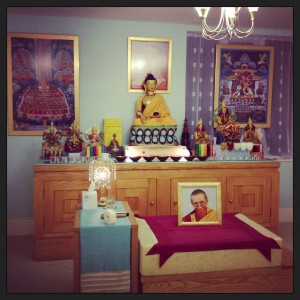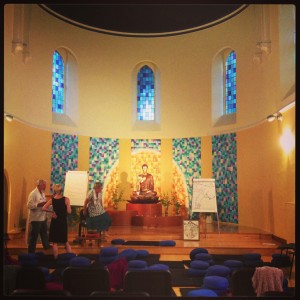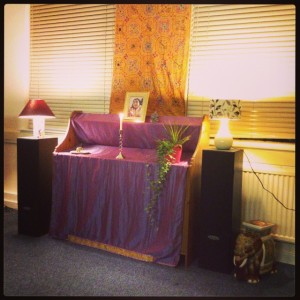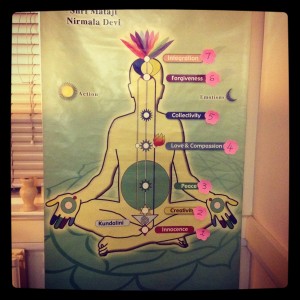I would like to get into the habit of meditating on a regular basis but lack discipline and motivation. My mind is constantly working overtime, analysing everything to death, so I am doubtful if I could ever truly learn to quieten it but that’s the dream. Sometimes, when I am fearful or anxious, I practice breathing exercises (counting 1 as I breathe in, 2 when I breathe out, up to 10) and recently I have been repeating the mantra “All is well” over and over in my head, which I believe featured in the dystopian film THX 1138 to pacify the masses. (After re-watching, it appears I may have adapted the phrase, “Stay calm, everything will be alright.”) Plus I have downloaded & listened to various guided meditations; one of which sounded like Danny from Withnail & I, “Change down, man. Find your neutral space. You got a rush. It’ll pass. Be seated.” However, more exploration is needed and in my quest for experience, I have visited 4 meditation centres in Sheffield over the last 2 years to discover the difference between their approaches and find one that resonates…
At the Gyaltsabje Kadampa Buddhist Centre in Hunter’s Bar, I enjoyed their use of visual imagery. “Imagine your body dissolving like pouring hot water over ice.” The room is cosy & comfortable and a chanting liberating prayer song is played at the beginning of each session in which joining in is optional. One verse brought tears to my eyes, “Please give me the light of your wisdom, To dispel the darkness of my mind, And to heal my mental continuum.” The resident teacher does a talk on a theme of his or her choosing & there is a chance to have a brief discussion with other members along with participate in a couple of meditations. They charge £5 per class & keep all their ornaments under lock & key, which interested me since the 3 other places I visited were all based on donations so that anyone regardless of income can afford to go. I understand that everyone has to make a living & survive in a material world but it seems to go somewhat against the ethos of spirituality not to offer such services free of charge.
Sheffield Buddhist Centre in Walkley is by contrast a community of absolute trust. You could buy a book or ornament from their shop by simply writing down your purchase & putting your money in the box. I bought a golden Buddha figure & a Mala beaded necklace. Their Triratna approach is more Western based & they have a large number of followers. However, as a converted Catholic church, I found the giant hall quite intimidating, although the energy has obviously shifted since. It was also allegedly a boys school, a hospital run by nuns and a home for wayward girls. I am more conscious of bodily noises (stomach rumbling, throat gurgling etc) in a huge assembly too. You have the option of sitting on a chair or a Zafu, a round cushion on the floor. During their introduction course, they provide handouts explaining the fundamentals of Buddhism (interconnectedness etc), which features useful advice & resembles cognitive behavioural therapy e.g. you are encouraged to stay in the gap rather than fall back into repetitive habits. Although the information was fascinating, I personally found the majority of their meditation exercises to be a little too structured & formulaic.
Sahaja Yoga near Abbeydale Road is based on cleansing your chakras & raising your kundalini to achieve an inner awakening or Self Realisation. They call the energy “Mother” and you are encouraged to experience a tingling sensation or cool breeze on your upturned hands & above your head (I could feel the former along with an airiness through my body). Each week’s meditation focused on clearing a chakra from the base of the spine upwards. There were also workshops which involved someone standing behind you, chanting and twiddling or fiddling with your energy. I appreciated the gesture but felt slightly uncomfortable as it seemed an intimate activity to be doing with a virtual stranger. I asked how it differed from Reiki & the leader explained that they are utilising your energy to heal from within rather than giving you their own. It was definitely the most kooky or “out there” practice I have experienced so far but seemed quite powerful.
Alternatively, the Brahma Kumaris encourage you to meditate with your eyes open. Initially, this seemed like an effective idea as it could make it easier to integrate mindfulness into everyday life. You could focus on an object such as a painting, candle or a photograph of the founder & everything around it became blurred & surreal; a reminder of the concept of the physical world being an illusion or Maya perhaps. I loved the teacher’s enthusiasm during her opening speech. She explained how in the supermarket, she’ll calmly ask, “So Baba (Father), shall we buy beans or spaghetti hoops?” and how she used to iron angry but now she glides. There was also a wonderful visualisation where you are a little diamond soul or orb of light hanging out with the supreme soul. But generally the hour-long meditation made me feel a little dizzy & disorientated & I realised I would prefer to close my eyes. So, 4 centres & 4 very different techniques which I may revisit in future in order to clarify my thoughts & preferences. My next step is to participate in a Mindfulness Based Life Enhancement course, which begins next week…






Another interesting read, Jen. Thank you.
‘Mind working overtime’ and ‘lack discipline’ are all too familiar.
I have found that there are so many techniques or dos and don’ts that they get in the way of the main objective which is to wind down the conscious mind. So, when I meditate, I only have one rule and that is to stop ‘thinking’. Breathing exercises are employed to aid with this but that is it. When I have mastered this technique and found the life space to be consistent with it, I might look at mantras or initialising a goal.
If I were to advise someone from my own experience, it would be:
• Don’t get bogged down with rules and techniques
• Take the process as far as YOU want to at that point in time and certainly don’t beat yourself up about not attaining a certain level.
• Whatever your technique is, enjoy it and feel at peace.
Aye, it’s easy to put pressure on yourself & get frustrated when your mind starts wandering or you feel some tension in your head as you are concentrating too hard. I must remember to try to let go & tell myself, “It is what it is” & not expect to achieve nirvana overnight. You’re right, simplicity is probably the key for consistency. At the moment, as much as I enjoy a guided meditation filled with visual imagery, I am more likely to take a few minutes on a daily basis to concentrate on my breathing.
Well written Jen.
The aim of meditation is to experience yourself as something other than your thoughts/mind – Something which feels more substantial and fufulfilling. Everyone who tries to quieten their mind during meditation becomes aware of how disatisfying it is to be constantly thinking and identified with the thoughts and corresponding body tension. Rather than forcing a still mind, what is important is recognising the dissatisfaction and deciding if you’re willing to let go of this usual way of being. Then you just keep doing that – noticing the dissatisfaction, the accompanying body tension. When you can notice it without pushing it away or being pulled into it, it loses its power and dissolves (although it often intensifies first). People that have been meditating for years sit there going through this process over and over, through the layers of the psyche. The only difference will be is that they are more trusting of the process through watching the cycles, and that they are more willing to relinquish the layers of the usual identity. A curiosity develops which counteracts fear and doubt. Also other things happen which make the process a way of living.